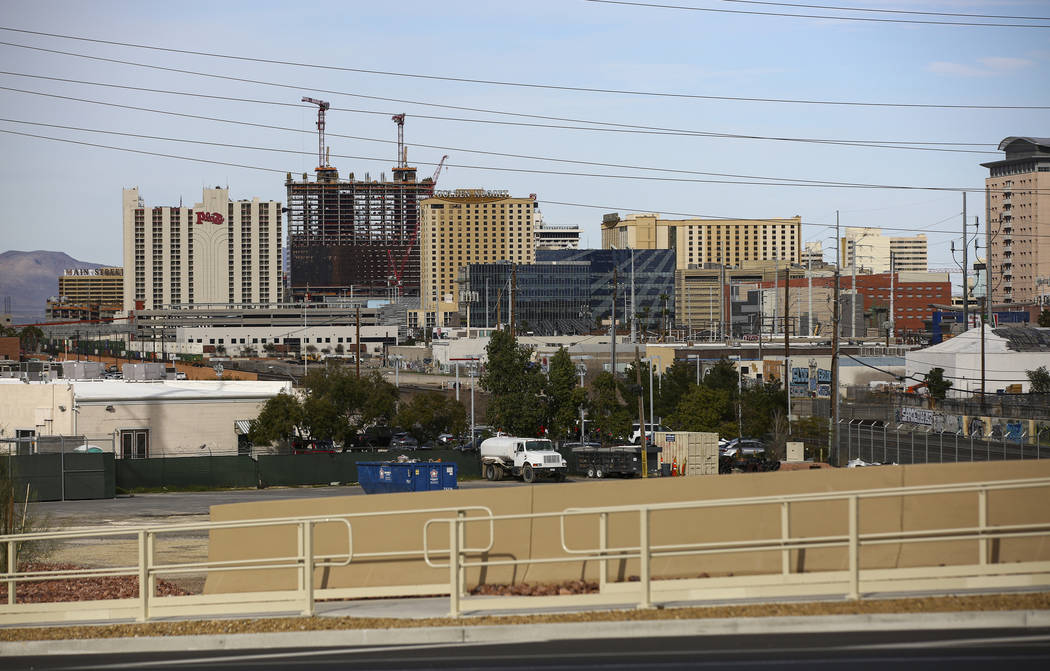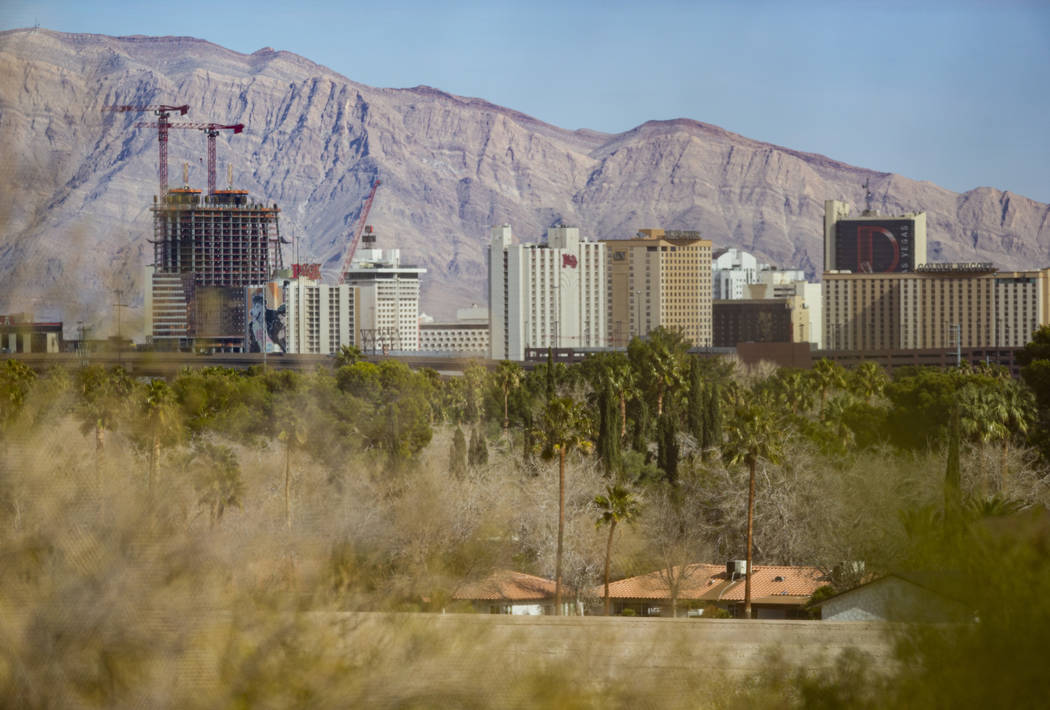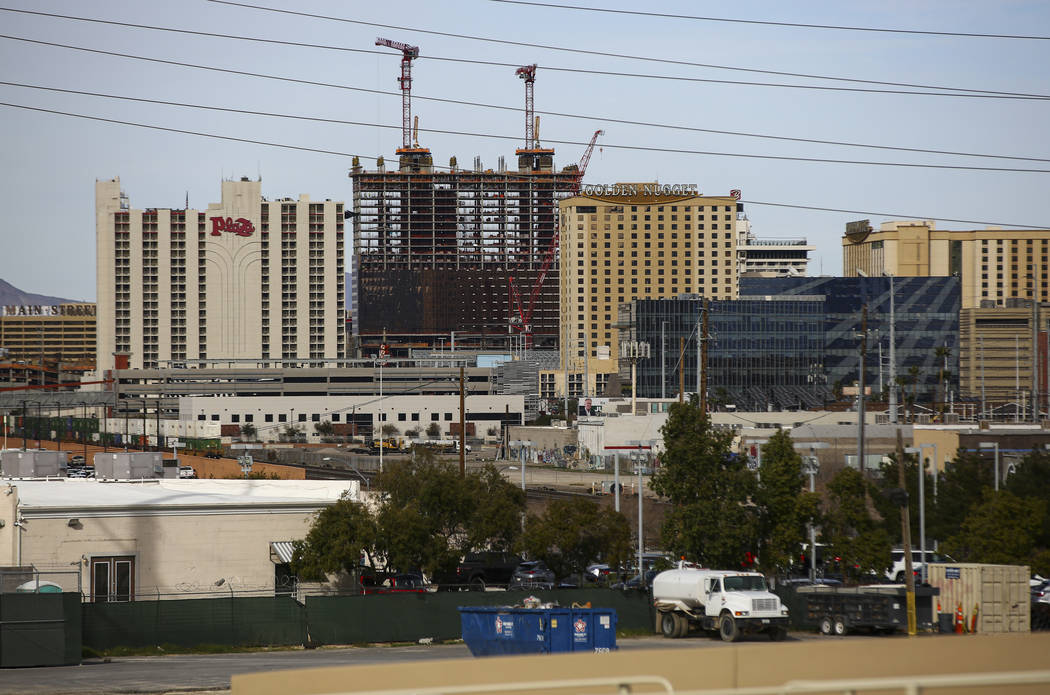‘Jetsons’ and tiny towns: Las Vegas looks skyward with plans for 2050
In downtown Las Vegas, kitty-corner to City Hall, there is a stand-alone Starbucks opened only a few years ago that Councilwoman Michele Fiore calls a “total waste of space.” It is too small of a use for such prime real estate, she said.
“That Starbucks is a perfect location for Starbucks,” Fiore said, “with 10 more stories on top of it.”
As Las Vegas continues to grow at a fast clip, projecting at least 300,000 new residents over the next three decades, it is also facing a problem: There is almost nowhere to build out horizontally except for the far northwest part of the city.
So city officials are looking skyward, figuratively and literally, as they finalize their 2050 master plan, a major blueprint that will inform policymaking and physical development over the next thirty years.
On Wednesday, Las Vegas City Council members met for several hours to set short-term priorities they believed would put the city on the right path to reaching long-term goals. Maximizing real estate was among them.
“This is where we have to go to make sure that space doesn’t limit us, is to build up, is to grow up,” Fiore said.
The lengthy discussion, interrupted only by a brief lunch break, also led to city lawmakers identifying several other areas to focus on during the first half of this decade: housing, transportation, education, parks, open spaces, and arts and culture.
But the council reached consensus to whittle its priorities to its three most important, which were public safety, health care and diversifying the economy.
Residents surveyed
The priorities largely corresponded to the topics more than 1,700 residents said were important to them in a survey conducted by Las Vegas-based research consulting firm Applied Analysis, with the 2050 master plan process.
Cost of living, public safety, family, employment and health care were listed as the top five reasons why respondents live in the city, according to the survey.
The priorities chosen during the council workshop, the first such meeting in three years, will be a guiding principle for a broad strategy with implications on how public money is spent, staff time is used and ordinances are crafted. The master plan, which incorporated public input, will also be the first since 2000, when then-city leaders adopted the planning document looking ahead to 2020.
Yet city lawmakers stressed that much of their three priorities bleed into other areas of focus and will work with each other, suggesting that issues seemingly overlooked were in fact very much a chief concern.
Nowhere was that assurance more underscored than with the fight to end homelessness.
Not an afterthought
As homelessness has become the pervasive issue of the moment in downtown, Councilman Cedric Crear, who said he hoped to have reduced homelessness by 90 percent in 2050, pressed colleagues to carve it out as a stand-alone focal point.
“I think that homelessness is not only a priority, I think it’s a capital-letter priority,” said Crear, who represents Ward 5, one of two downtown districts.
But others insisted that chronic homelessness rolled into public safety, health care and other categories. Mayor Carolyn Goodman said it was more important to fix it than to ensure that the city’s economy expanded beyond its signature gaming and hospitality industries.
“If there’s homelessness, you will not have a diversified economy, you will not have an economy because everything will move out of this city to where the homeless aren’t,” she said.
Goodman maintained that issue — which city officials are fearful could explode as it has in Los Angeles — was one of the foremost reasons why the Las Vegas Raiders chose to relocate to unincorporated Clark County over the city.
Tiny towns
Fiore also drew a parallel between combating homelessness and making the most of available real estate, saying the city’s Courtyard Homeless Resource Center should have been built 10 to 15 floors tall.
And as the city struggles to lure mega-companies like an Amazon or Google, at least in part because of lacking available land, Fiore said city lawmakers needed to secure the space to grow outward.
“No. 1 priority needs to be annexation with dirt from the BLM and dirt that’s just sitting there that’s owned by some of our friends that own it, the developers out there that are just keeping it dirt,” she said.
Fiore clarified Friday that she was not referring to using eminent domain on private property, which she said she opposed. But instead the city could ask land owners if they would sell unused lots, she said, if the city was to attract the interest of a major company.
She envisioned more land providing the city with negotiating ability: offering incentives to big corporations on the condition the companies agree to build a community for homeless individuals behind their development, with resources including job training and counseling.
“We’ll give them free land, they build a tiny town,” she said at Wednesday’s meeting.
Accessibility is key
Conversations about homelessness were bound to spill over into housing, which Crear said cannot alone be the solution to the issue, pointing to how Los Angeles has spent hundreds of millions of dollars on housing but is still facing a crisis.
Councilman Brian Knudsen said he wants to better understand the city’s role in new housing. With the population expected to continue to boom into the midcentury, he said the key question now and then will be whether there are enough accessible places for people to live.
“I think about … preserving our quality of life, preserving our neighborhoods that we have now, while still knowing there’s another 500,000 people that will move in,” he said.
Knudsen said it is his goal to fill gaps where they exist throughout the city on multiple fronts including housing, transportation, education and health care.
In the Applied Analysis survey, 54 percent of respondents said that health care in the city was no better than “average” while 19 percent reported it was “poor” or “terrible.” Jeremy Aguero, a principal analyst for the research firm, said the responses were more indicative of accessibility than quality.
Knudsen, who represents Ward 1, which encompasses the city’s Medical District, said the city could control issues such as health care and education — oftentimes dismissed as outside local government authority — by creating the conditions for those sectors to thrive.
“We are a city that can influence a lot, and we need to practice our level of influence,” he said.
Councilwoman Olivia Diaz said that one area to nurture should be workforce training programs for young people.
“We need to start planning for them now so that we’re not slammed in 2050 with a shortfall of doctors, of tech people and whatever the up-and-coming careers are,” she said.
Don’t forget today
Aguero cautioned that the survey, while illustrating “a relatively strong response” from residents on quality-of-life issues, made it clear that respondents were more interested in preservation than progress — thinking about tomorrow more so than 30 years from now.
So as the city prepares to adopt its future-thinking plan in coming months, officials acknowledged the need to strike a balance between immediate solutions and prescient policies. Citing the survey showing residents generally disconnected from neighbors and social organizations, Diaz said she wanted to increase the sense of community.
Diaz said she was concerned about making parks safer, although survey respondents gave the park system generally good reviews across all wards. She also said the city should be more responsive to mitigate vacant homes that cause problems for neighbors.
Michael Sherwood, the city’s Information Technologies director, said that it will remain incumbent on city leaders to cultivate a business-friendly environment and to guide implementing new technology down the road.
As Fiore spoke about the need to build more skyscrapers downtown, she said she also envisioned 2050 as not unlike “The Jetsons,” where flying cars descend on top of skyscraper ports similar to helipads.
Later during the workshop, Sherwood revisited the idea of a Jetsons-like future.
“That’s a true possibility,” he said. “That’s probably sooner rather than later.”
Contact Shea Johnson at sjohnson@reviewjournal.com or 702-383-0272. Follow @Shea_LVRJ on Twitter.
2050 Master Plan by Las Vegas Review-Journal on Scribd
Las Vegas in 2050 likely to add at least:
— 72 million square feet of commercial space
— 300,000 residents
— 100,000 housing units
— 9,500 acres of parks
— 2,500 teachers
— 1,100 city employees
— 600 Metro officers
— 450 public safety employees
— 30 CCSD schools
Source: City of Las Vegas






















